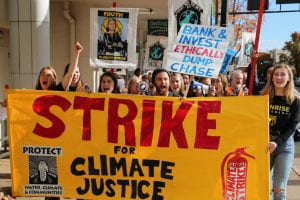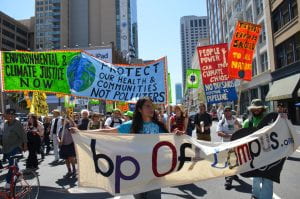Introduction
In recent years, states across the U.S. have threatened to cut ties with banks and asset managers that incorporate Environmental, Social, and Governance (ESG) screening into their accounting, or otherwise screen for climate risk. Although this movement seems in some ways to have come out of nowhere, telltale signs of such a backlash have been evident for at least several years now, and likely even longer. To fully comprehend the current state of the law, in short, it is necessary to first look to the recent past. This analysis will consider, briefly, how such bills perhaps came to be, and subsequently how they may be countered through Constitutional claims, existing financial regulations, and other legal frameworks.
Anti-ESG laws may best be understood as a “backlash to a backlash.” Socially conscious investing is almost as old as America itself, and the modern controversy over climate risk parallels conflicts over sugar and cotton boycotts by abolitionists during the antebellum period. From early opposition to slavery to modern screening against forced labor, finance has sometimes embraced social conscience. Although sustainable investing in the modern era was arguably first popularized by the Equator Principles—and ESG as a term was first coined by the United Nations in the early 2000s—the notion of corporate social responsibility is much older.
Historically, boycotts were envisioned as a response to investor and buy-side risk, but also as part of a broader human rights framework. Boycotting (or “negative screening,” in modern parlance) was one way to shift financial flows away from industries that did not respect human rights while raising awareness of serious supply chain problems that harmed workers or communities. As the market for ESG experts has exploded in recent years, sustainable finance has, in some ways, grown around and beyond its roots. Though the focus on emissions at times eclipses other human rights frameworks—the “E” in ESG sometimes overshadowing other social concerns—the roots of corporate social responsibility in human rights advocacy are a key reason why some carbon majors seem to see any type of ESG as an existential threat. Increased investor scrutiny, no matter how minimal, increases the risk that more compliance and in-house attorneys will actually read the fine print. What is lurking in the fine print may be, in some cases, subject to severe civil or even criminal penalties under existing financial compliance frameworks, as discussed in the conclusion of this blog.
In short, the single best way to combat this “backlash to a backlash” requires unravelling how it developed, and returning to the roots of where many sustainable finance frameworks began: Not simply disclosure, but actual divestment.
Anti-ESG backlash also follows a period of increased hostility towards peaceful environmental protests in other contexts. According to Global Witness, non-violent environmental defenders around the world were killed or disappeared on average roughly once every two days over the past decade, although this is likely an undercount. Since the early days of the pandemic, when most of us were distracted baking sourdough bread and trying to survive quarantine, the legal landscape around climate protests has also shifted dramatically. Perhaps most notably, the Escazu Agreement entered into force. As the world’s first binding treaty to explicitly protect environmental defenders, the Escazu Agreement was a turning point – although, notably, the United States and many other countries are not signatories. In contrast to the progress embodied by Escazu, journalists and advocacy groups have increasingly criticized the rise of bills criminalizing peaceful environmental protests across the United States in recent years, in large part as a result of fossil fuel lobbying. Although seemingly a world away from the boardrooms where the battles over ESG adoption were playing out, this was, in hindsight, an early bellwether of things to come.
Since then, the anti-ESG movement has snowballed, shifting from targeting grassroots activists to taking on some of the nation’s largest banks. The fossil fuel industry and the American Legislative Exchange Council (ALEC), an organization that has previously been criticized for supporting the criminalization of environmental activists, are also among the key players in the current anti-ESG backlash. This is yet another example of how the present reflects the past.
If not challenged in its current form, this movement will likely continue to build in scope and scale. There is no reason to believe, within this broader context, that the current spate of anti-ESG bills are one-off events. Rather, they are a coordinated step in a multi-year strategy to undermine criticism of the oil and gas industries.
Large asset managers, the current targets of this movement, are uniquely poised to slow or even stop it. With large corporate war chests and access to legal counsel beyond the capacity of many indigent defendants, fund managers could challenge anti-ESG laws on their merits. Already, states with anti-ESG policies have been projected to increase their costs of borrowing by potentially hundreds of millions of dollars. Challenging anti-ESG legislation provides an opportunity to act, not simply to react.

Credit: Fabrice Florin, Flickr (Creative Commons)
Constitutional Claims
Notably, the merits of the First Amendment arguments around anti-protest bills more broadly are slightly beyond the scope of this analysis. However, arguments around potential First Amendment problems with such legislation parallel potential concerns with anti-ESG bills. Litigating the boundaries of commercial speech—including ESG disclosures—could be an innovative approach to countering many of these bills. One of the cornerstone Supreme Court cases concerning commercial speech, Central Hudson, has been previously invoked by commentators arguing against the SEC’s proposed climate risk rule. Although this article does not take the position that government regulation of climate risk disclosures infringes on corporate speech, this appears to be a widely held belief in the anti-ESG movement. Yet, logically, if it is the case that regulating climate risk disclosures infringes on corporate speech, then those disclosures must also be a form of corporate speech. Thus, they are beyond the reach of state law to wholly restrict. Under the Central Hudson test, commercial speech is protected if it concerns lawful activity and is not misleading. Government restrictions on such speech must advance a substantial interest, and regulation must be no broader than necessary. Thus, if the SEC regulated misleading ESG disclosures, such action would likely be protected under this standard, but states retaliating against banks with any form of ESG screening likely would not.
One such model bill supported by anti-ESG advocates refers to “branding, advertising, statements, explanations, reports, letters to clients, communications with portfolio companies, statements of principles, or commitments” as examples of potentially regulated conduct. This text would, if written into state law, almost certainly place an unconstitutional burden on corporate speech, extending even beyond regulating commercial speech, and seeking to restrict the speech of individual employees.
Furthermore, this model bill would also place likely unconstitutional restrictions on freedom of association. Although the legal history of boycotts in America is complex, boycotts have widely been considered protected speech since NAACP v. Claiborne. For this reason, claims that banks are “boycotting” the fossil fuel industry in anti-ESG laws further point toward the argument that ESG standards are, in fact, a form of protected speech, in addition to potential anti-trust arguments.
Even setting aside First Amendment claims, preemption creates a larger structural problem with anti-ESG laws. Historically, certain areas of American law are subject to field preemption under the Supremacy Clause, where the will of Congress supersedes state legislation by occupying the field. Field preemption is a form of implied preemption. This means that, although it may be inferred through the presence of a robust federal regulatory regime, there is not always a bright-line rule for whether a specific state policy will be preempted. Field preemption in the context of securities regulation is somewhat murky, but certain complex forms of securities enforcement have traditionally been the domain of the SEC and other federal agencies. Preemption specifically in the context of securities law has been litigated for decades, and many courts have struggled to draw a sharp line. Given such controversy, might there be another Constitutional claim here?
In addition to field preemption, other forms of preemption under U.S. law—namely, implied or conflict preemption, where there is an implicit conflict between state and federal law—might also be at issue if the SEC finalizes its disclosure rule. If large financial institutions are required to report on climate risk under federal law, but barred from any discussion of climate risk under state law, then federal law would win out. Given the extraordinary controversy around the SEC’s proposed rule, it may be potentially vulnerable to the Congressional Review Act, although this is arguably less likely after the recent midterm elections. Regardless of the fate of the SEC rule, we may turn to the root rationale behind the inclusion of federalism in the American system: Limiting conflict between the states.
To the extent that the Supremacy Clause is a well-developed body of American law, it is intertwined with the Dormant Commerce Clause, under which states may not unduly limit commerce between other states. Allowing states to regulate interstate commerce themselves has historically created protectionist regimes that limit trade and damage the economy as a whole. Although the Dormant Commerce Clause is sometimes invoked as a specter against states seeking to block interstate pipelines or other fossil fuel expansion, there is a strong record of state control over interstate infrastructure, either through 401 certifications under the Clean Water Act, or through other measures to protect health and safety. What is less clear, however, is the extent to which individual states may attempt to stop the flow of not simply oil or gas, but securities.

Credit: Steve Rhodes, Flickr (Creative Commons)
Under past Supreme Court precedents such as City of Philadelphia v. New Jersey, state laws may not burden interstate commerce strictly for economic protectionism but may still impose incidental restrictions on commerce to protect health and safety. Under this analysis, state-level ESG guidance seeking to protect state residents from environmental or other harms could be permissible. However, restrictions on interstate commerce solely on the basis of economics—even assuming anti-ESG laws improved financial returns—are less clearly viable.
Under Reeves, Inc. v. Stake, there is also an exception to the Dormant Commerce Clause for states acting as a market participant—something that may provide the rationale for screening, supposedly “woke” banks out of state pension funds (although such screening is not without its own legal challenges). This safe harbor is limited, however, and requires consideration of downstream effects.
Given the outsized economic impacts of Vanguard, BlackRock, and other behemoth asset managers, anti-ESG state laws may well fall beyond this exception to the rule. Anti-ESG laws are a novel iteration of securities law, which contain broader and at times more controversial and charged language than past regulatory regimes. Insofar as such laws may be considered a case of first impression, it is difficult to determine how courts may react. Certain jurisdictions, such as the Fifth Circuit, have also shown hostility to the SEC’s regulatory authority in recent years, creating another wild card to consider in judicial review. Nevertheless, even if Constitutional claims are too risky to litigate, anti-ESG laws may also violate existing legal obligations.
Separate Legal Obligations
Shifting from a disclosure regime to a stricter compliance regime may be harder for anti-ESG laws to undermine, since anti-money laundering (AML) compliance and similar criminal safeguards are rooted in federal laws like the Bank Secrecy Act and the Patriot Act. Essentially, transitioning to more of an AML framework would mean establishing a distinct legal basis for ESG screening. Rather than simply classifying sectors or companies based on , a compliance regime would look at social risk—the “S” in ESG—and argue that screening and divestment in certain sectors is not merely a discretionary duty, but a mandatory one. For example, one model anti-ESG bill contains a carve-out for divesting from fossil fuel companies not following “controlling federal or state law.” In theory, this would provide a safe harbor for screening any fossil fuel firm that has violated any of its environmental permits, or even been subject to any kind of fine.
Additionally, this strategy could aid in transparency in extractive industries that may not have been properly vetted in the first place. Many carbon-intensive sectors have serious alleged violations lurking in their supply chains, from forced labor to human trafficking, that could trigger legal obligations under existing AML frameworks which would heavily screen or even cut off financing. Alleged child labor in the supply chains of highly polluting U.S. corporations, as litigated under the Alien Tort Statute (ATS) in Nestle v. Doe, may also be cognizable in AML screening for forced labor. Given that corporate interests have fought for decades to weaken the ATS, AML or ESG screening that includes extraterritorial supply chains is likely to be seen by bad actors as a significant threat.
The wariness around ESG may in part be a concern that these links to organized crime in extractive industries may be discovered, and provide a pathway to corporate accountability. Although the anti-ESG movement takes a reactionary view of climate risk disclosure as a moral crusade, this characterization is not wholly misplaced. Investors who become concerned by climate risk as an economic or regulatory risk may, as they learn more about the reality of extractive industries, come to see investing in fossil fuels as an ethical risk as well.
This analysis is necessarily brief, barely skimming the surface of many of the legal theories that could challenge anti-ESG laws. Yet, the common thread between each of these theories is that the anti-ESG movement contains a fundamental undercurrent of hostility toward human rights. It seeks unconstitutional restrictions on free speech and freedom of association and attempts to turn investors away from looking too closely into the supply chains they fund. It is an attempt to sever the human connection that lies at the heart of much of finance – the fundamental concern for both shareholders and future generations about what their world will look like, and for those on the other side of the world who are burdened by the costs of careless consumption. Countering this movement not only makes legal sense, but is also a statement about what the future should look like, and who gets to decide.
Robin Happel is a recent graduate of the Elisabeth Haub School of Law. This blog was selected as a runner up for the inaugural Student Prize for Emerging Theories of Climate Accountability in September 2023; any views expressed are solely her own, not the views of her employer or made in any official capacity.

